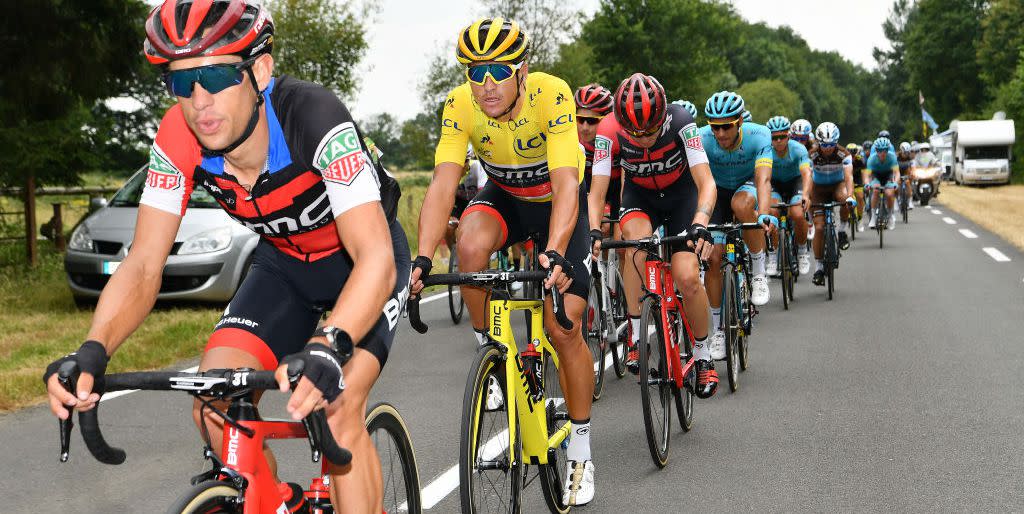Are Tour de France Riders Actually Healthy?

The Tour de France is nearly inarguably the hardest endurance event on the planet. Exercise scientists have calculated the riders’ TRIMP value (“training impulse,” or training volume multiplied by training intensity; a metric like Strava’s suffer score) for the 21-day beat down at an astronomical 7,112. For reference, the TRIMP for running a marathon is about 300. During the race, some riders become increasingly catabolic, eating into their own muscle tissue faster than they can replace it. They also become pseudo-anemic as they rip through red blood cells, and their immunity plummets as their free radical damage rises.
So, yeah, nobody would call the Tour itself particularly “healthy.” But all those weeks when they’re not straddling the razor-thin wire between lighting it up and going down in flames? The pros seem to reap some lasting rewards even though some risks remain. Here’s how they stack up against typical folks who have to ride their office chairs more than their bicycles for three weeks in July.
Fitness

To state the obvious: Tour de France riders are fit. By the gold standard measurement of cardiovascular fitness, V02 max (or how much oxygen your body can use per minute), they’re pretty much twice as fit as the average non-Tour rider of the same age range who’s in fair to good shape. That typical human has a V02 max of about 40 ml/kg/min to 45 ml/kg/min. Research shows that top Tour riders need to clock a minimum of 80 ml/kg/min to be in serious contention.
Body Composition
No surprise here, Tour riders (though some appear lacking in upper body muscle) have healthier than average body compositions across the board. Climbers, of course, tend to be whippet thin at an average height of 5’8” to 5’10” and an average weight of just 132 to 145 pounds. Time trial specialists, while still very lean, are bigger and heavier, averaging 5’10” to 6’0” in height and 154 to 165 pounds in weight. Podium contenders are a little lighter, but closer to TT build. By contrast, the average American man is currently 5’9” and 195.5 pounds and the average woman is currently 5’4” and 166.2 pounds.
Mortality
Despite some fears that too much exhausting exercise (like grinding over Alpine summit after summit after summit) might take years off one’s life, research finds that Tour riders go on to outlive the rest of us. One study that compared the death rates of more than 830 Tour riders from France, Italy, and Belgium with those in the general population found that the cyclists lived an average of 17 percent longer (living until 81.5 years old vs. 73.5).
Skeletal Health
This one could be a chink in the armor, quite literally. Competitive cyclists are at risk for low bone density if that’s all they do, because cycling is a non-weight bearing sport. University of Oklahoma researchers who scanned the skeletons of 32 competitive male road cyclists aged 18 to 45 found that nearly all of them had lower bone density than their same-age peers who weren’t competitive cyclists. Some even had osteopenia, a precursor to osteoporosis. That tide may turn, however, as the younger generation of professional cyclists routinely perform more bone-building strength and power training, and new research reveals that today’s 19-year-olds are as sedentary as 60-year-olds.
Heart Health
This one’s sticky. Endurance training makes your heart bigger, so it can pump more blood to your working muscles. That’s a good thing for boosting your V02 max. But there’s questions if it doesn’t also account for the fact that endurance athletes are at increased risk for a heart rhythm problem called atrial fibrillation that causes an irregular, often more rapid than normal, heart beat for a given level of activity.
"Much, but certainly not all, of the increased longevity among Tour cyclists is thought to be due to better cardiovascular health," says Larry Creswell, MD, a cardiologist who commonly sees endurance athletes as patients. "Perhaps that's no surprise. But there may indeed be some cardiac risk that comes with long-time cycling. Although rare, there are examples of professional riders with cardiac arrest, or 'heart attack,' either during training or competition, and this often occurs in relatively young riders. We also know that long-time endurance athletes of all sorts, cyclists included, have higher than expected rates of atrial fibrillation. While atrial fibrillation is generally considered to be a 'benign' arrhythmia, this condition can be associated with other important problems such as stroke. Tour cyclists are an amazing breed and we could learn more from careful study of their heart health over their lifetimes."
You Might Also Like

